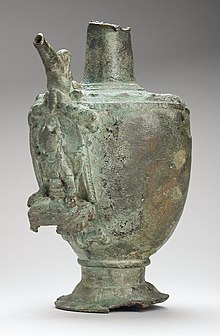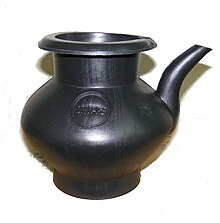Lota (vessel)
 From Wikipedia - Reading time: 5 min
From Wikipedia - Reading time: 5 min




A lota (Hindi: लोटा; Odia: ଲୋଟା/ନୋଟା; Urdu: لوٹا) is a small, spouted, and rounded jug that has been used in India[1] since the 2nd millennium BCE or earlier.[2] Normally there is no handle. The design itself serves multiple purposes; a copper lota is commonly used in Indian religious ceremonies, such as yajna during puja, for wedding rituals, and other sacred traditions. It is also used for serving water and liquor.[3][4] According to the ancient Indian/Hindu-origin traditional medicine system of ayurveda, drinking water stored in the copper lota has health and nutritional benefits.[5]
The vessel's regional variations include the bodna (Bengali: বদনা) in Bengal, the kindi in Kerala, and the Karuwa in Nepal.
History
[edit]The earliest known examples of lota and kindi in ancient India are from the Chalcolithic period, notably in the Savalda Culture and two well-preserved examples from the pottery of the Jorwe Culture, dating back to the 2nd millennium BCE.[2][6] Highly decorative spouted vases with floral motifs are also known from Chandraketugarh, dating back to around the 2nd century BC or the 1st century CE. The earliest lotas were made of clay or teracotta while modern versions are notably metal.[7]
Design
[edit]Regional variations
[edit]In West Bengal and parts of Bangladesh, the term bôdnā (Bengali: বদনা) describes spouted (teapot-like) vessels, and the vessels used for puja are called ghôt or ghôti, while lotā is used for cleansing mugs.[8] In Odisha, vessels without the spout is also known as lota, while spout vessel is known as Jeri, used for prayer rituals and serving liquor.[9][3] They are also known as Karwa, Jharis and Achaman Jharis (utensils with spouts) in Hindi Belt and Gujarat in northern and western India, used for prayer rituals.[10] It is also known as Mooku sombu and Pal Kindi used as milk feeder for babies in southern parts of India. In Nepal, it is known as Karuwa which is used for religious rituals, serving water and liquor.[4]
Reception
[edit]American designers Charles and Ray Eames in their The India Report expressed a great admiration for the lota, saying about its design, "Of all the objects we have seen and admired during our visit to India, the Lota, that simple vessel of everyday use, stands out as perhaps the greatest, the most beautiful."[11][12][13]
Usage
[edit]Idioms and literature
[edit]In some parts of the Indian subcontinent, the use of the phrase "bependi ka lota" (a "lota without a base") is colloquially used to refer to a person who may switch their loyalties. This comes from the observation that a spherical lota without a base tends to roll over in unpredictable directions when kept on uneven ground. The neologism "lotacracy" was coined in Pakistan to describe politicians who switch parties for their convenience.[14]
Ayurveda
[edit]According to the ancient Indian/Hindu-origin traditional medicine system of ayurveda, drinking water stored in the copper lota has health and nutritional benefits.[5] It is used for jala neti, a traditional ayurvedic and yogic practice that is used for cleansing the nose and sinus passages through nasal irrigation.
Sacred ceremonies
[edit]In the Indian-origin religions, the lota is a multi-purpose utensil. It is also used in the sacred rituals,[3] such as yajna, puja, for wedding rituals, and other sacred ceremonies.
Cleansing
[edit]
Throughout the Indian subcontinent, the lota is commonly used to assist with hygiene, such as during baths or anal cleansing.[15]
In Bengali, the term lotā is used for bath mugs.
See also
[edit]- Aftabeh, a similar vessel used in Iran, Azerbaijan, and Central Asia
- Ghatam, a large water pot related to the lota design
- Kalasha, a metal pot used in Hindu rites—the lota is a type of falsha
- Anal cleansing, for which a lota is commonly used
Citations
[edit]- ^ "Definition of Lota". Merriam-Webster's Online Dictionary. Retrieved 22 March 2007.
- ^ a b Singh, Upinder (2008). A History of Ancient and Early Medieval India: From the Stone Age to the 12th Century. Delhi: Pearson Education. pp. 229–233. ISBN 978-81-317-1120-0.
- ^ a b c Daniel Miller, 1985, Artefacts as Categories: A Study of Ceramic Variability in Central India, pages 126–130.
- ^ a b "Seven reasons why Tansen is one of the must-see places in Nepal". OnlineKhabar English News. Retrieved 27 February 2021.
- ^ a b 11 Amazing Healing Benefits of Drinking Water in a Copper Vessel, NDTV, 6 July 2018.
- ^ "Excavations - Important - Maharashtra". Archaeological Survey of India. Archived from the original on 11 October 2011. Retrieved 1 September 2010.
- ^ "Lota: A Must-Have for Every Hindu Home". IndianShelf. Retrieved 10 November 2024.
- ^ Akbar, Javaria (11 December 2014). "A Muslim's Guide to Anal Hygiene". Vice. Retrieved 9 September 2019.
- ^ "Odisha State Tribal Museum | Jeri".
- ^ Jhariji, Achaman Jhariji And Karwa https://inbrindavan.com/jhariji-achaman-jhariji-karwa/
- ^ Demetrios, Eames (9 February 2002). "An Eames Primer". Universe Publishing. Retrieved 22 March 2007.
- ^ "Eames' India Report". National Institute of Design, Ahmedabad, India. Archived from the original on 9 March 2007. Retrieved 22 March 2007.
- ^ "Charles & Ray Eames India Report, April 1958", Design Observer
- ^ Gauhar, Humayun (24 January 2011). "Blasphemy…or a convenience?". Saudi Gazette. Okaz Organization for Press and Publication. Archived from the original on 30 March 2012. Retrieved 24 January 2011.
- ^ Donald Albrecht (2009). The Work of Charles and Ray Eames: a Legacy of Invention. Harry N. Abrams. ISBN 9780810927520. Retrieved 5 September 2011.
India and Pakistan have a water culture, so that it is preferable to use a lota to cleanse with after using the washroom.
External links
[edit]- Bodna Nai—Music video depicting the extinction of the bodna from urban Bangladesh
- The Lota Blog—A comedic blog about the use and application of the lota in modern times
- Nuevos Habitos—An artist dedicated to lota and other stuff
- [1] - HOW TO USE A LOTA: THE SECRET TO ISLAMIC HYGIENE.
 KSF
KSF